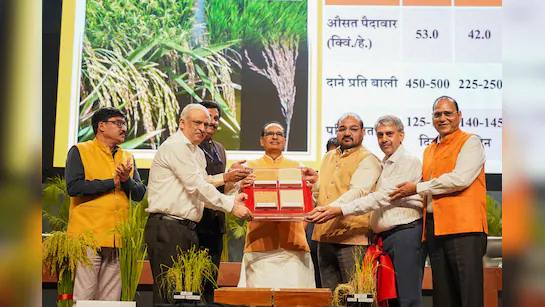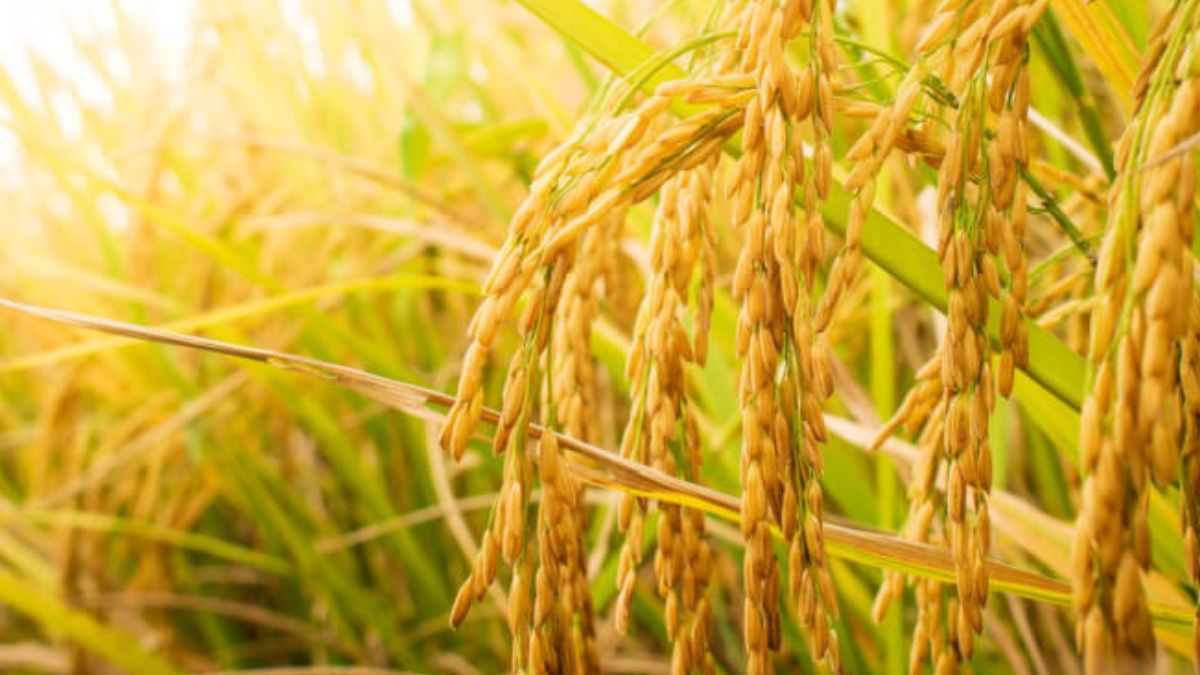- Courses
- GS Full Course 1 Year
- GS Full Course 2 Year
- GS Full Course 3 Year
- GS Full Course Till Selection
- Online Program
- GS Recorded Course
- NCERT (Recorded 500+ Hours)
- Polity Recorded Course
- Geography Recorded Course
- Economy Recorded Course
- AMAC Recorded Course
- Modern India, Post Independence & World History
- Environment Recoded Course
- Governance Recoded Course
- Science & Tech. Recoded Course
- International Relations and Internal Security Recorded Course
- Disaster Management Module Course
- Ethics Recoded Course
- Essay Recoded Course
- Current Affairs Recoded Course
- CSAT
- 5 LAYERED ARJUNA Mentorship
- Public Administration Optional
- ABOUT US
- OUR TOPPERS
- TEST SERIES
- FREE STUDY MATERIAL
- VIDEOS
- CONTACT US
World's 1st Rice Variety Using 21st Century "Genome Editing" Produced In India
World's 1st Rice Variety Using 21st Century "Genome Editing" Produced In India

- The Indian Council of Agricultural Research (ICAR) has successfully developed the world’s first genome-edited (GE) rice varieties using CRISPR-Cas technology.
- These varieties have been developed without introducing any foreign DNA, making them distinct from genetically modified (GM) crops.
- This achievement marks a major step in the advancement of precision agriculture in India.
- The development of such varieties adds to India's growing agricultural export, with Rs 48,000 crore worth of Basmati rice being exported annually.
- Institutions Involved
- Indian Institute of Rice Research (IIRR) – Hyderabad
- Indian Agricultural Research Institute (IARI) – New Delhi
- These institutions are affiliated with Indian Council of Agricultural Research and jointly contributed to the research and development of the genome-edited rice varieties.
Research Methodology
- Selection of Varieties: Scientists selected 2 highly cultivated varieties for improvement:
- Samba Mahsuri (BPT5204): Known for fine grain quality but vulnerable to climate stress.
- MTU1010 (Cottondora Sannalu): High yielding but sensitive to drought and soil salinity.
- Genome Editing: ICAR enhanced these varieties to make them more resilient to stress, improve yield, and provide better climate adaptability.
Technology Used : Genome Editing Technology
- CRISPR-Cas9 System: This technique leads to desirable traits like increased yield, climate resilience, and improved disease resistance without the introduction of foreign DNA.
|
What is CRISPR-Cas9?
Key Components
How CRISPR-Cas9 Works:
Applications:
|
- Methods Applied: ICAR used SDN-1 for both rice varieties.
- Cas Enzymes Used:
- CRISPR-Cas12 for Samba Mahsuri (Kamala)
- CRISPR-Cas9 for MTU-1010 (Pusa DST Rice 1)

What is Site-Directed Nucleases (SDN)
|
Type |
Description |
Regulatory Status in India |
|
SDN-1 |
Cuts DNA at a specific site, natural repair occurs without a DNA template or foreign gene |
Allowed |
|
SDN-2 |
Cut + small template from same species guides precise edits |
Allowed |
|
SDN-3 |
Insertion of foreign genes from other species |
Not allowed (regulated as GMO) |
DETAILS OF THE TWO GE RICE VARIETIES
2 new varieties developed through genome-editing technology:
- Kamala (IET-32072)
- Parent Variety: Samba Mahsuri (BPT-5204) – known for fine grain quality.
- Gene Edited: Gn1a (cytokinin oxidase 2) → controls grain per panicle.
- Editing Objective: Downregulation → increased grains/panicle → improved yield.
- Technology Used: CRISPR-Cas12
- Maturity: 130 days (15–20 days earlier than parent)
- Yield:
- Average: 5.37 tonnes/ha
- Potential: 9 tonnes/ha
- (Parent: Avg. 4.5 t/ha; Potential: 6.5 t/ha)
- Cultivation Zone: ~5 million ha in TN, AP, Telangana, Odisha, WB, Bihar, Chhattisgarh, Jharkhand, eastern UP.
- Pusa DST Rice 1 (IET-32043)
- Parent Variety: MTU-1010 (Cottondora Sannalu) – popular Rabi crop.
- Gene Edited: DST (Drought and Salt Tolerance) gene.
- Objective: Introduce abiotic stress tolerance (drought/salinity).
- Technology Used: CRISPR-Cas9
- Maturity: 125–130 days
- Cultivation Zone: ~4 million ha in southern, central, and eastern India.
Yield under Stress Conditions:
|
Condition |
GE Yield (t/ha) |
Parent Yield (t/ha) |
|
Inland salinity |
3.508 |
3.199 |
|
Alkaline soils |
3.731 |
3.254 |
|
Coastal salinity |
2.493 |
1.912 |
Features of Genome-Edited Rice Varieties
- Yield Increase: The new rice varieties provide a 25% higher yield compared to traditional rice varieties.
- Water Efficiency: These varieties require less water, saving a significant amount in irrigation.
- Climate Resilience: Designed to be more climate-resilient and adaptable to varying environmental conditions.
Significance and Benefits
- Environmental Benefits: These varieties are designed to reduce greenhouse gas emissions (by 20%) and save up to 7,500 million cubic meters of water for irrigation.
- This can be used for other crops, improving the overall water-use efficiency in agriculture.
- Impact on Climate Change: The new varieties can address challenges posed by climate change, such as rising temperatures, irregular rainfall, and water scarcity.
- Global Historical Milestone: India became the first nation to produce genome-edited rice varieties, marking a significant step in global agricultural innovation.
Not a GM Crop
- Non-GM: These rice varieties are not genetically modified (GM). No foreign DNA has been introduced into the plants.
- The genome editing done is within the existing genetic material of the rice, making them safe and free from the controversies surrounding GM crops.
Key Differences Between Genome-Edited (GE) and Genetically Modified (GM) Crops:
|
Aspect |
Genome-Edited (GE) Crops |
Genetically Modified (GM) Crops |
|
Definition |
Editing of native genes within the plant’s own genome |
Insertion of genes from unrelated species into the plant genome |
|
Use of Foreign DNA |
No foreign DNA is used |
Foreign DNA from other organisms is introduced |
|
Example |
Kamala and Pusa DST Rice 1 (edited versions of Samba Mahsuri and MTU-1010) |
Bt cotton (contains genes from Bacillus thuringiensis) |
|
Technology Used |
CRISPR-Cas with SDN-1 or SDN-2 |
Recombinant DNA technology |
Regulation of Gene Editing in Agriculture in India:
|
Regulatory Aspect |
Gene Editing in India |
|
GMO Regulation |
GMOs are regulated under the ‘Rules for the Manufacture, Use, Import, Export and Storage of Hazardous Microorganisms/ Genetically Engineered Organisms or Cells, 1989 under the Environment Protection Act (EPA), 1986. Regulated by GEAC (Genetic Engineering Appraisal Committee)
|
|
Mention of Gene Editing |
No explicit mention of gene editing in the existing regulations |
|
Amendment |
An amendment was introduced to encourage gene editing in agriculture |
|
Techniques Using Native Genome (SDN-1, SDN-2) |
Allowed under the EPA, 1986 regulations as they do not involve foreign DNA |
|
Techniques Using Foreign Genome (SDN-3, SDN-4, SDN-6) |
Not allowed in India; these fall under GMO regulation as they introduce foreign DNA |
|
Gene Editing Exemption |
SDN-1 and SDN-2 are exempt from stringent GMO regulation due to their use of native genes |
Field Trials and Approval
- Both the GE rice varieties were tested under multi-location field trials.
- These trials were conducted in 2023 and 2024.
- The trials were part of the All India Coordinated Research Project (AICRP) on Rice.
- The Department of Biotechnology’s Review Committee on Genetic Manipulation (RCGM) approved the trials and confirmed that the varieties are free from exogenous DNA.
- This allowed the varieties to be treated as non-GM crops.
Launch and Government Support
- In the Union Budget 2023–24, the Government of India allocated ₹500 crore to promote genome-editing research in agriculture.
- ICAR is using this funding to expand gene-editing efforts to other crops.
- These include pulses, oilseeds, livestock breeds, fish species, and beneficial microbes.
- GE crops under SDN-1 & SDN-2:
- Declared equivalent to conventionally bred lines
- Approved for multi-location trials and commercial release
- Not regulated as GMOs
Intellectual Property Rights (IPR) Issues
- The CRISPR-Cas9 gene-editing system is patented by the Broad Institute of MIT and Harvard.
- Its use in India is under license.
- ICAR has acknowledged that intellectual property rights (IPR) issues exist regarding this technology.
- However, the organization has stated that these concerns are being addressed and will be resolved in due course.
GM Crops in India :
- Approved GM Crop
- Bt Cotton (since 2002)
- Why used? Resists cotton bollworm.
- How? Contains genes from Bacillus thuringiensis (Bt), which produce Cryoproteins toxic to insects.
- Bt Cotton (since 2002)
- Pending/Restricted GM Crops
- Bt Brinjal
- Approved in 2009 by GEAC, but put on hold (moratorium).
- Contains cry1Ac gene from Bt for insect resistance.
- Field trials for two new types (Janak & BSS-793) were allowed in 8 states.
- GM Mustard (DMH-11)
- Developed by Delhi University’s Centre for Genetic Manipulation of Crop Plants.
- Not yet released for commercial use.
- Made by crossing two mustard types: Varuna & Early Heera-2 (normally self-pollinating).
- Genes Used:
- Barnase – Makes plant male-sterile (stops self-pollination).
- Barstar – Reverses barnase effect in hybrid, allowing fertility.
- Bar – Gives resistance to herbicide "Basta" (for selection).
- Goal: Create a high-yield hybrid mustard.
- Bt Brinjal
Concerns with GM Crops
- Ecological Risks
- Genetic contamination of wild species.
- Pest and weed resistance (e.g., pink bollworm, whitefly).
- Harm to non-target species like butterflies.
- Biodiversity Threat
- Soil damage from GM proteins.
- Harm to helpful microbes and insects.
- Economic & Ethical Issues
- Yields not always better (Bt cotton stagnation).
- Corporate control of seeds = market monopoly.
- Ethical worries about long-term effects.
- Risk of allergens in food.
Recommendations (Parliamentary Committee)
- Better Regulation – More transparency in GEAC, include MPs in district panels.
- Scientific Review – Do real-world trials, measure true yield, pesticide use, and environmental impact.
- Labeling – Make GM food labeling mandatory for informed consumer choice.
- Animal Studies – Test effects on livestock and fish.
- National GM Policy – Clear policy for GM crop research, farming, and trade.
|
Also Read |
|
| NCERT Books For UPSC | |
| UPSC Monthly Magazine | Best IAS Coaching in Delhi |




